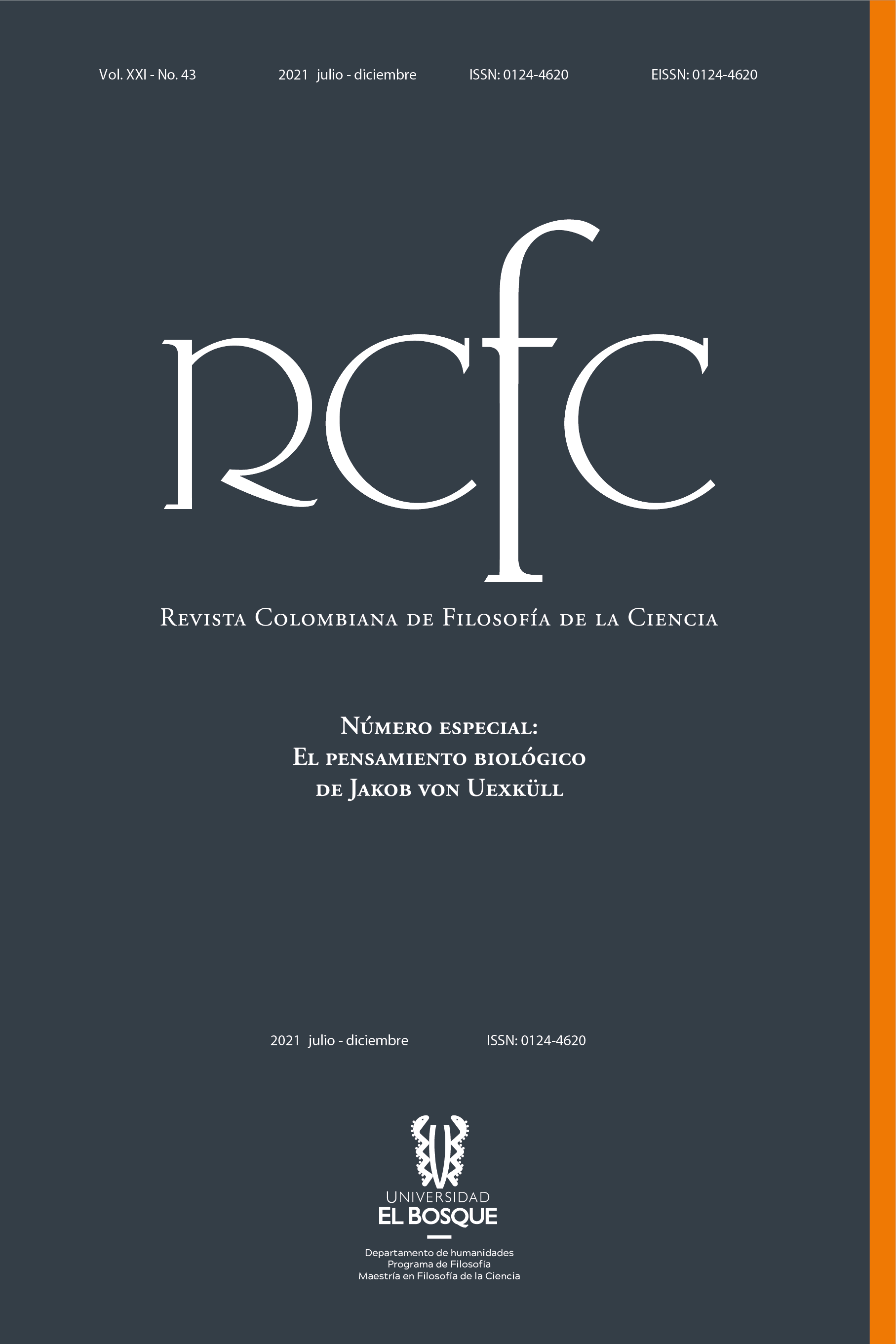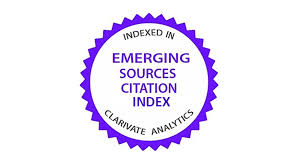Organization, experience, and adaptation. Three biosemiotic connections between von Uexküll’s thought and Maturana and Varela’s enactive biology
DOI:
https://doi.org/10.18270/rcfc.v43i21.3365Keywords:
biosemiotics, functional circle, autopoiesis, Umwelt, structural couplingAbstract
From a biosemiotic point of view —that is, focusing on how meaning and life co-emerge and are closely related— this article intends to establish three connections between the theories of the Estonian biologist Jakob von Uexküll and the theories of the Chilean biologists Humberto Maturana and Francisco Varela. Such connections will be made by examining three general questions about life and sense-making in organisms: how meaning is tied to organization, experience, and adaptation. Thus, the text will investigate the interweaving and complementary ideas between both von Uexküll’s and Maturana and Varela’s most salient theories: specially, between the concept of functional circle and autopoiesis; between Umwelt and enactive world, and between adaptive counterpoint and structural coupling.
Downloads
References
Andrade, Eugenio. “A semiotic framework for evolutionary and developmental biology”. Biosystems. 90.2 (2007): 389–404. Web. https://doi.org/10.1016/j.biosystems.2006.10.003
Barbieri, Marcello. The organic codes: An introduction to semantic biology. Cambridge, UK.; New York: Cambridge University Press, 2003. Impreso
–––. Introduction to biosemiotics: The new biological synthesis. Dordrecht, the Netherlands: Springer, 2008. Impreso.
Bateson, Gregory. Mind and Nature: A Necessary Unity. New York: Dutton, 1979. Impreso.
Bitbol y Luisi. “Autopoiesis with or without cognition: Defining life at its edge”. Journal of The Royal Society Interface. 1.1 (2004): 99–107. Web. https://doi.org/10.1098/rsif.2004.0012
Brentari, Carlo. Jakob von Uexküll the Discovery of the Umwelt between Biosemiotics and Theoretical Biology. Dordrecht: Springer Netherlands, 2015. Impreso.
De Jaegher, Rohde y Di Paolo. Enaction: Toward a New Paradigm for Cognitive Science. Cambridge; London: MIT Press, 2010. Impreso.
Deacon, Terrence. W. Incomplete nature: How mind emerged from matter. New York: W.W. Norton & Co, 2012. Impreso.
Di Paolo, Ezequiel. “Extended Life”. Topoi. 28.1 (2009): 9–21. Web. https://doi.org/10.1007/s11245-008-9042-3
Di Paolo y Thompson (2014). “The Enactive Approach”. The Routledge Handbook of Embodied Cognition. Ed. Shapiro L. Routledge, 2014. 68–78. Web. https://doi.org/10.4324/9781315775845
Farina y Belgrano. “The eco-field: A new paradigm for landscape ecology”. Ecological Research. 19.1 (2004): 107–110. Web. https://doi.org/10.1111/j.1440-1703.2003.00613.x
–––. “The Eco-field Hypothesis: Toward a Cognitive Landscape”. Landscape Ecology. 21.1 (2006): 5–17. Web. https://doi.org/10.1007/s10980-005-7755-x
Favareau, Donald. Essential readings in biosemiotics: Anthology and commentary. Dordrecht: Springer, 2010. Impreso.
Freeman, Walter. Neurodynamics: An Exploration in Mesoscopic Brain Dynamics. New York: Springer Science & Business Media, 2012. Impreso.
–––. How Brains Make Up Their Minds. New York: Columbia University Press, 2000.
Fuster, Joaquín M. “The cognit: A network model of cortical representation”. International Journal of Psychophysiology. 60.2 (2006): 125–132. Web https://doi.org/10.1016/j.ijpsycho.2005.12.015
Gallagher y Zahavi. The phenomenological mind. London; New York: Routledge, 2012. Impreso.
Gibson, James. J. (2011). The ecological approach to visual perception. New York: Psychology Press.
Hoffmeyer, Jesper. Signs of meaning in the universe. Bloomington: Indiana University Press, 1998. Impreso.
–––. (2014). “The semiome: From genetic to semiotic scaffolding”. Semiotica. 2014.198 (2014): 11-31. Web. https://doi.org/10.1515/sem-2013-0099
Hutto y Myin. (2017). Evolving Enactivism: Basic Minds Meet Content. Cambridge; London: The MIT Press, 2017. Impreso. https://doi.org/10.2307/j.ctt1q1xq5g
Kockelman, Paul. The art of interpretation in the age of computation. New York: Oxford University Press, 2017. Impreso
Lagerspetz, Kari Y. H. “Jakob von Uexküll and the origins of cybernetics”. Semiotica. 2001.134 (2001): 643-651. Web. https://doi.org/10.1515/semi.2001.047
Lakoff y Johnson. Philosophy in the flesh: The embodied mind and its challenge to Western thought. New York: Basic Books, 2010. Impreso.
Lorenz, Konrad. Studies in Animal and Human Behaviour. Cambridge: Harvard University Press, 2014. Impreso.
Lotman, Juri. “On the semiosphere”. Sign Systems Studies. 33.1 (2005): 205–229. Impreso.
Luhmann, Niklas. Organización y decisión: Autopoiesis, acción y entendimiento comunicativo. Barcelona: Anthropos, 2005.
Maran, Timo. Ecosemiotics: The Study of Signs in Changing Ecologies. Cambridge: Cambridge University Press, 2020. Web. https://doi.org/10.1017/9781108942850
Maturana R., Humberto. La realidad: ¿objetiva o construida? fundamentos biológicos de la realidad II. Barcelona: Anthropos, 2009. Impreso.
Maturana R. y Varela. El árbol del conocimiento: Las bases biológicas del conocimiento humano. Buenos Aires: Lumen, 2003. Impreso.
Mingers, John. Self-producing systems: Implications and applications of autopoiesis. New York: Springer Science+Business Media, LLC, 2013. Impreso.
Morton, Timothy. The ecological thought. Cambridge: Harvard University Press, 2010. Impreso.
Niño, Douglas. Elementos de semiótica agentiva. Bogotá: Universidad de Bogotá Jorge Tadeo Lozano, 2015. Impreso.
Peirce, Charles. Sanders. Collected Papers of Charles Sanders Peirce [CP]. Eds. P. Weiss Hartshorne y Burks A.W. Cambridge: Harvard University Press, 1960. Impreso.
Peterson, Thornburg, Kissel, Ball y Fuentes. “Semiotic Mechanisms Underlying Niche Construction”. Biosemiotics. 11.2 (2018): 181–198. Web. https://doi.org/10.1007/s12304-018-9323-1
Rodríguez Gómez, Sergio. “Cartographies of the mind: Generalization and relevance in cognitive landscapes”. Sign Systems Studies. 47.3/4 (2019): 382–399. Web https://doi.org/10.12697/SSS.2019.47.3-4.02
Sharov y Vehkavaara. “Protosemiosis: Agency with Reduced Representation Capacity”. Biosemiotics. 8.1 (2015): 103–123. Web. https://doi.org/10.1007/s12304-014-9219-7
Thompson, Evan. Mind in Life. Cambridge: Harvard University Press, 2007. Impreso.
–––. Reseña de “Evolving Enactivism: Basic Minds Meet Content por D. Hutto y E. Myin. Notre Dame Philosophical Reviews. 11 de ene. de 2018. Web. https://ndpr.nd.edu/news/evolving-enactivism-basic-minds-meet-content
Varela, Maturana y Uribe. “Autopoiesis: The organization of living systems, its characterization and a model”. Biosystems. 5.4 (1974): 187–196. Web. https://doi.org/10.1016/0303-2647(74)90031-8
Varela, Palacios y Goldsmith. (1993). “Color vision of birds”. Vision, Brain and Behavior in Birds. Eds. Bischof H.-J. y Zeigler H. P. Cambridge: MIT Press, 1993. 77–98. Impreso.
Varela y Maturana. “Mechanism and Biological Explanation”. Philosophy of Science. 39.3 (1972): 378–382. Web. https://doi.org/10.1086/288458
Varela, Francisco J. Conocer. Barcelona: Gedisa, 2013. Impreso.
Varela, Thompson y Rosch. De cuerpo presente: Las ciencias cognitivas y la experiencia humana. Barcelona: Gedisa, 2011. Impreso.
von Uexküll, Jakob. “A Stroll Through the Worlds of Animals and Men. A Picture Book of Invisible Worlds”. Instinctive Behavior. The Development of a Modern Concept. Ed. Schiller C. H. New York: International Universities Press, Inc, 1934. 5-80. Impreso.
–––. “The Theory of Meaning”. Semiotica. 42.1 (1982). Web. https://doi.org/10.1515/semi.1982.42.1.25
von Uexküll, Thure. “Introduction: Meaning and science in Jakob von Uexküll’s concept of biology”. Semiotica. 42.1 (1982): 1–24. Web. https://doi.org/10.1515/semi.1982.42.1.1
–––. “Introduction: The sign theory of Jakob von Uexküll”. Semiotica. 89.4 (1992). Web. https://doi.org/10.1515/semi.1992.89.4.279
Wilson y Stevenson. Learning to smell: Olfactory perception from neurobiology to behavior. Baltimore: Johns Hopkins University Press, 2006. Impreso.
Wu, Wayne. Attention. London; New York: Routledge, 2014.
Downloads
Published
How to Cite
Issue
Section
License

This work is licensed under a Creative Commons Attribution-NonCommercial-NoDerivatives 4.0 International License.

| Article metrics | |
|---|---|
| Abstract views | |
| Galley vies | |
| PDF Views | |
| HTML views | |
| Other views | |











